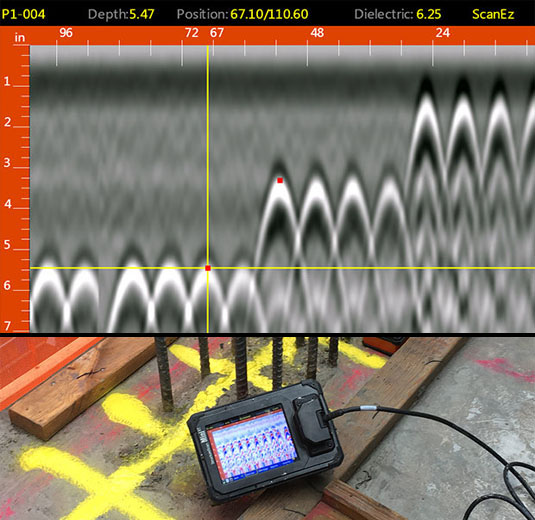Picking the Right Concrete Scanning Devices
Picking the Right Concrete Scanning Devices
Blog Article
Past the Surface: Leveraging Advanced Concrete Scanning Techniques for Unmatched Precision and Insight
In the realm of building and construction and facilities upkeep, the mission for accuracy and thoroughness is never-ending. Advanced concrete scanning techniques have actually emerged as essential tools in this quest, supplying a look beneath the surface area to unveil a globe of important understandings. By taking advantage of sophisticated technologies, specialists can uncover abnormalities, assess the problem of concrete structures, and make notified decisions that shape the training course of projects. The ramifications of these strategies prolong far past plain surface-level analyses, promising a depth of precision and understanding that is unparalleled.
Relevance of Advanced Concrete Scanning
The significance of utilizing sophisticated concrete scanning methods depends on the unparalleled precision they provide for finding sub-surface abnormalities and ensuring structural integrity. By utilizing innovative modern technologies such as ground-penetrating radar (GPR), electromagnetic induction, and advanced sonar imaging, building specialists can delve below the surface of concrete structures with a level of accuracy that far goes beyond typical inspection methods. Concrete Scanning. These techniques make it possible for the identification of covert threats like rebar rust, spaces, channels, or post-tension cable televisions that could jeopardize the stability and safety of a structure gradually
Additionally, advanced concrete scanning offers very useful understandings right into the total condition of a concrete component without the demand for invasive steps, minimizing the threat of triggering damage throughout the evaluation process. The ability to determine the precise location and depth of possible issues enables targeted fixings and upkeep, inevitably prolonging the lifespan of the structure and optimizing its efficiency. Essentially, the importance of innovative concrete scanning can not be overstated in the realm of building and construction and facilities upkeep, where accuracy and dependability are paramount.
Sorts Of Cutting-Edge Technologies

Anomalies and Problem Detection

Along with GPR, concrete scanning strategies like thermography and impact-echo screening are also reliable in spotting abnormalities and flaws. Thermography utilizes infrared technology to identify variants in surface temperature, showing possible locations of worry such as delamination or dampness access. On the other hand, impact-echo testing involves assessing acoustic feedbacks to detect voids, splits, and various other flaws within the concrete. By leveraging these sophisticated techniques, experts can proactively deal with structural concerns, ensuring the long life and security of concrete structures.
Assessing Concrete Problem
Exactly how can designers properly examine the condition of concrete frameworks to ensure their longevity and safety and security? Numerous advanced concrete scanning strategies are employed for this function. Ground-penetrating radar (GPR) is typically try this web-site utilized to assess the internal structure of concrete, detecting spaces, fractures, and various other abnormalities that might jeopardize its stamina.
Additionally, aesthetic inspection continues to be an essential component of concrete condition analysis. Engineers aesthetically examine the find out this here surface for indications of degeneration, such as spalling, fracturing, or staining. Combining non-destructive testing techniques with visual assessments permits for a comprehensive assessment of concrete condition, enabling designers to identify possible concerns beforehand and implement prompt upkeep or fixings. By leveraging these sophisticated techniques, engineers can ensure the lasting durability and safety of concrete frameworks.
Enhancing Decision-Making Processes
In the realm of framework administration, optimizing decision-making procedures is critical for making certain the efficient upkeep and long life of concrete frameworks. Enhanced decision-making processes in concrete management include utilizing advanced scanning strategies to collect detailed data on the condition of structures. By leveraging modern technologies such as ground-penetrating radar and 3D imaging, stakeholders can make enlightened decisions regarding replacement, repair service, or support approaches.
These progressed scanning strategies offer important insights into the interior structure of concrete, identifying potential concerns such as voids, fractures, or deterioration that might not show up on the surface area. This level of comprehensive info permits for proactive maintenance planning, reducing the threat of structural failings and raising the overall life-span of concrete frameworks.
Furthermore, by incorporating electronic documents and analysis devices into the decision-making procedure, stakeholders can track the evolution of concrete conditions over time, making it possible for predictive upkeep techniques and maximizing resource appropriation. Eventually, the combination of reference innovative concrete scanning strategies improves decision-making processes by providing unparalleled precision, understanding, and efficiency in infrastructure monitoring.
Verdict
Finally, advanced concrete scanning strategies offer unequaled accuracy and insight in detecting abnormalities, defects, and evaluating the condition of concrete structures. By leveraging sophisticated modern technologies, decision-making procedures can be enhanced, causing more efficient and informed options for keeping and fixing concrete framework. These strategies play an essential duty in ensuring the security and longevity of concrete frameworks, making them an essential tool in the area of building and construction and engineering.
Additionally, advanced concrete scanning gives very useful insights into the overall problem of a concrete aspect without the need for invasive steps, lessening the danger of triggering damages throughout the evaluation procedure - Concrete Scanning. An additional innovative modern technology is 3D X-ray scanning, which provides in-depth photos of the interior framework of concrete, using beneficial information without the requirement for harmful testing. Additionally, Concrete Cover Meters are utilized to determine the density of concrete cover over reinforcement bars properly. Improved decision-making procedures in concrete administration include making use of advanced scanning methods to collect thorough data on the condition of frameworks.In conclusion, advanced concrete scanning strategies supply exceptional accuracy and understanding in spotting anomalies, defects, and evaluating the problem of concrete frameworks
Report this page